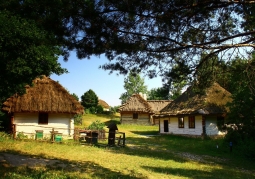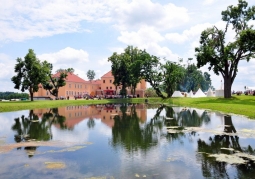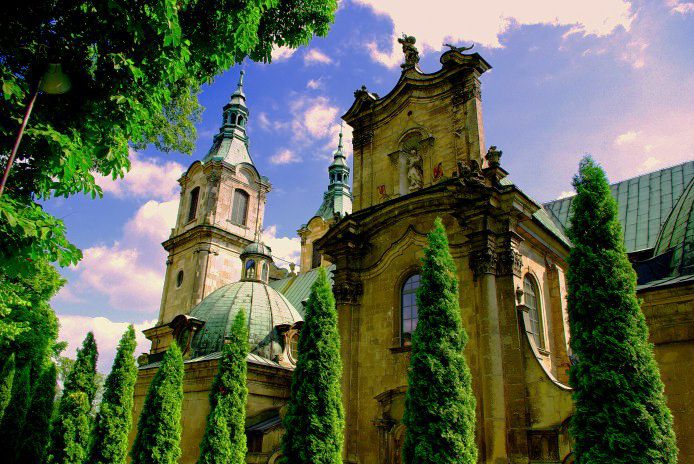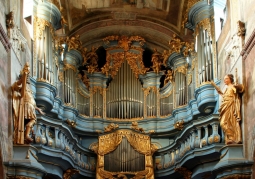Cistercian Archdiocese - Jędrzejów
No weather data
0.0 /5
Number of ratings: 0
Jędrzejów Abbey is the oldest Cistercian abbey in Poland. It was founded in 1140 by Janik Jaksa, later archbishop of Gniezno and his brother Klemens. The monks came to the settlement called Brzeźnica from French Morimond. Jędrzejów Monastery was founded as the twenty-first branch of the monastery in Morimond. Therefore, to distinguish him from his matrix, he was called "Lesser Morimond". The founder Janik equips the monastery with part of his patrimony - eight villages. In addition, the Bishops of Cracow gave the Brzeźnik church tithes from several villages. The monks also received a one-nave church from the founders St. Wojciech (or St. Andrew), dated 1110. To this day, the tower and a fragment of the apse of this temple, which was built in the Romanesque style, has survived. This church was consecrated by the bishop Maura of Kraków. One of the amber routes led through the market settlement, to which the monks came, as well as the road leading east - via Andreovia. The monks came to this place to convert the peoples of Ruthenia. The monks built a monastery and a monastery church. This venture ended with a consecration in 1210. The church was consecrated by the bishop of Kraków, Wincenty Kadłubek, who eight years later abandoned the bishopric with the consent of the pope, and joined the Cistercians in Jędrzejów. The temple bears the call of the Assumption of the Blessed Virgin Mary and St. Adalbert. The monks took care of the local population on various levels of life: whether spiritual - they ran nearby parishes, or cultural - small elementary schools, whether medical or health - hospice, hospital. They also dealt with fish farming. The monastery had mills, a sawmill, and a glassworks. The monks ran an organ building plant. The economic ruin of the monastery was largely due to events such as the Swedish Deluge, during which the abbey was looted, or fires in 1726 and 1800. In the first of the fires the church burned down, the walls were damaged and the ceiling was destroyed. The second fire turned out to be worse for the monastery itself. The archives and the library, in which the letter of St. Bernard to the Cistercians of Jędrzejów, as well as the original Chronicle Polonorum of Master Wincenty. After these events, the abbey did not return to its splendor. To make matters worse, in 1819 Tsar Alexander I dissolved. Although monks could stay in the monastery walls, they could not accept candidates for religious. And so, over time, the community became extinct. The last of them was moderated by Wilhelm Ulawski in 1855. Later, the Franciscan Reformers took care of the monastery for a short time. However, it did not last long, because for helping the insurgents of the January Uprising they were removed from Jędrzejów. It was then that a Russian male teacher's seminar was created here. At the end of the 19th century, the branch of the Holy Trinity church was founded in the abbey. In 1913, thanks to the bishop of Kielce, Augustyn Łosiński, an independent parish was created, run by a diocesan clergy. The Cistercians returned to their monastery after World War II, thanks to Bishop Czesław Kaczmarek. They returned from the abbey in Szczyrzyc. Initially, it was a prior Prize dependent on Szczyrzyc, from 1953 an independent prior, and from 1989 an abbey. The first abbot after resurrection was Father Paweł Marian Lubański.
Komentarze
No results
Nearby places

Noble castle ruins - Mokrsko Górne
Category: LocksThe ruins of the castle built in the years 1519–1526 in the late Gothic style by the Grand Marshal of the Crown Piotr Kmita. The castle was significantly expanded at the end of the 16th and 17th centuries. In the 18th...
12 km

Knight's Castle - Sobków
Category: LocksThe castle in Sobków rose from the ruins - the spirit of Josaphat Szaniawski was at large in Świętokrzyskie. The castle in Sobków is a surprise from start to finish; from the top of the corner tower to the corner of...
13 km

Museum of the Kielce Village - Ethnographic Park - Tokarnia
Category: Open-air museumsThe captivating, immersed in greenery, picturesquely located open-air museum in Tokarnia near Kielce, is a place that I can recommend with a clear conscience to everyone, especially to the townspeople. I often visit...
17 km

Branicki fortifications - Podzamcze
Category: Manor housesIt was established at the beginning of the 17th century on the order of the staroste of Chęciny, Jan Branicki, on the place of the farm. After the desolation of Checiny, including the Chęciny castle by the Swedes,...
20 km
Nearby places

Noble castle ruins - Mokrsko Górne
Category: LocksThe ruins of the castle built in the years 1519–1526 in the late Gothic style by the Grand Marshal of the Crown Piotr Kmita. The castle was significantly expanded at the end of the 16th and 17th centuries. In the 18th...
12 km

Knight's Castle - Sobków
Category: LocksThe castle in Sobków rose from the ruins - the spirit of Josaphat Szaniawski was at large in Świętokrzyskie. The castle in Sobków is a surprise from start to finish; from the top of the corner tower to the corner of...
13 km

Museum of the Kielce Village - Ethnographic Park - Tokarnia
Category: Open-air museumsThe captivating, immersed in greenery, picturesquely located open-air museum in Tokarnia near Kielce, is a place that I can recommend with a clear conscience to everyone, especially to the townspeople. I often visit...
17 km

Branicki fortifications - Podzamcze
Category: Manor housesIt was established at the beginning of the 17th century on the order of the staroste of Chęciny, Jan Branicki, on the place of the farm. After the desolation of Checiny, including the Chęciny castle by the Swedes,...
20 km


